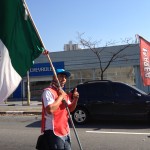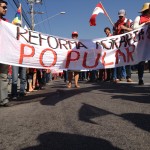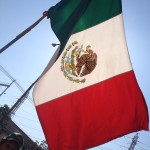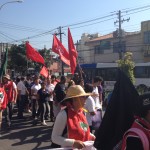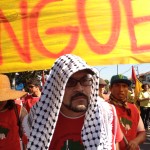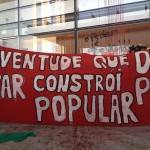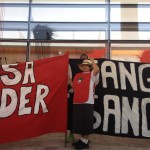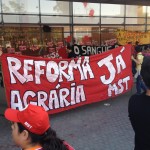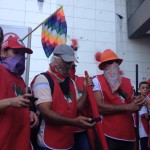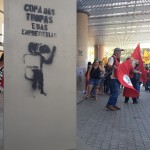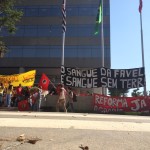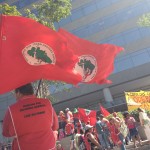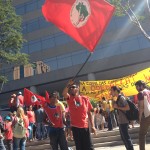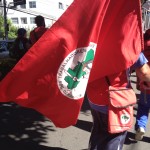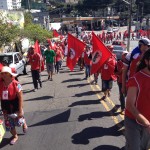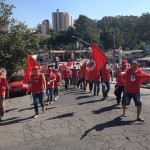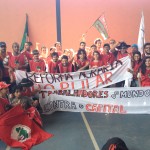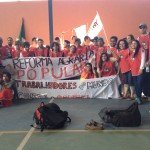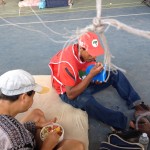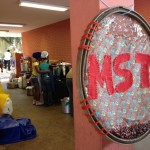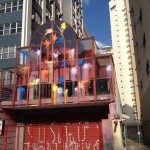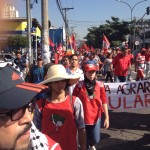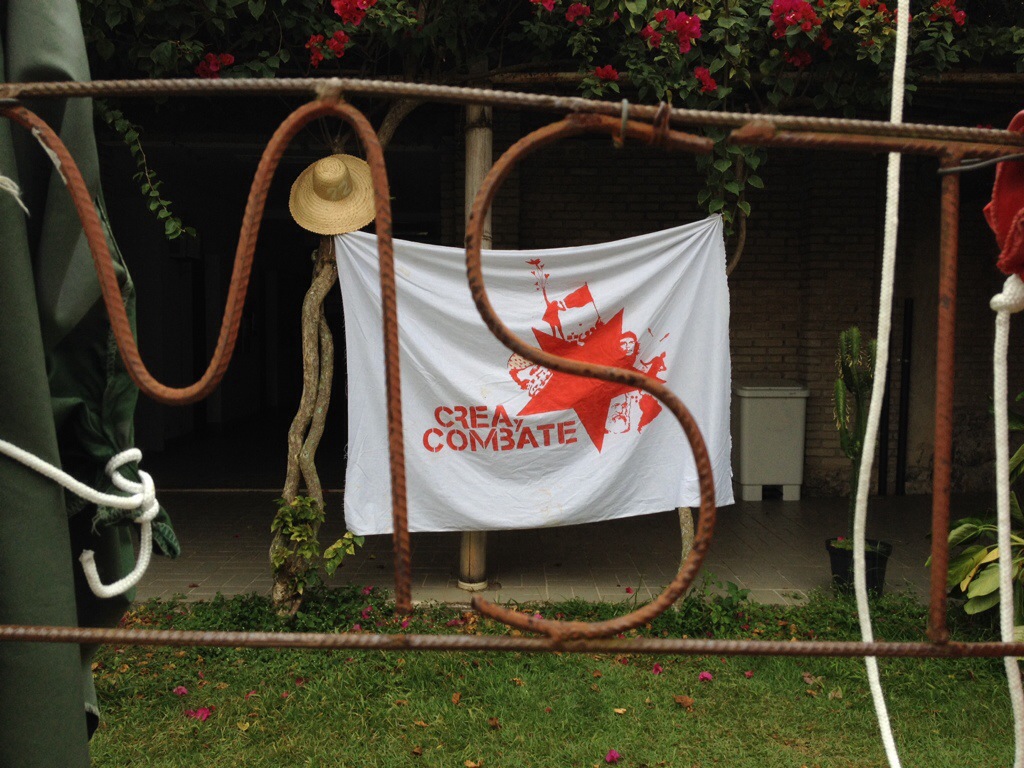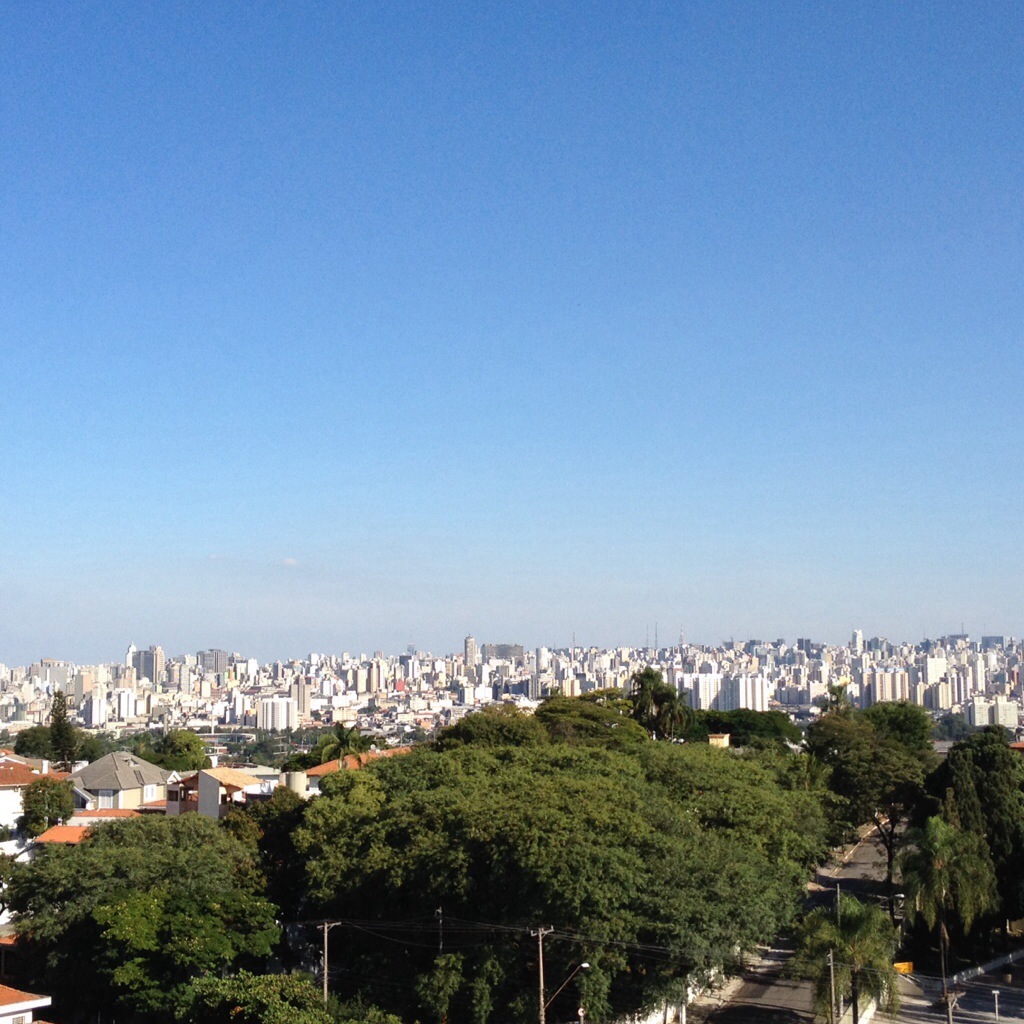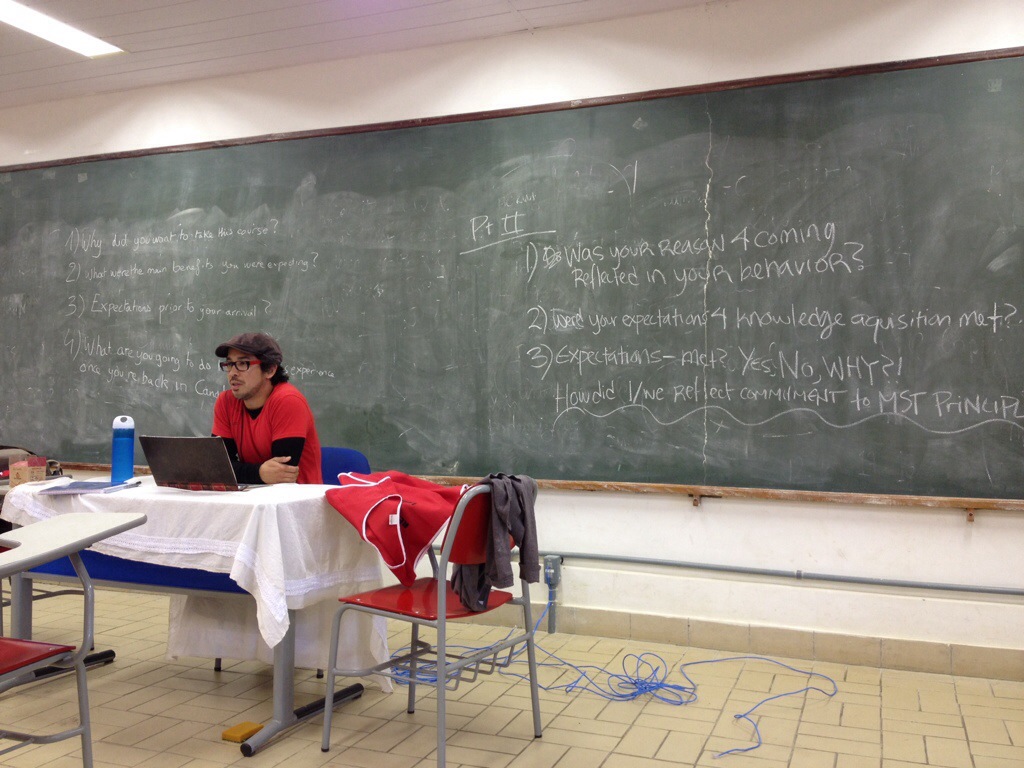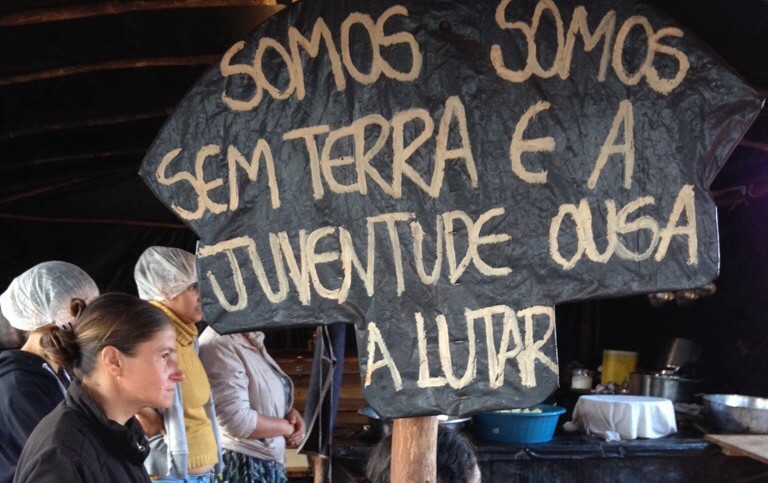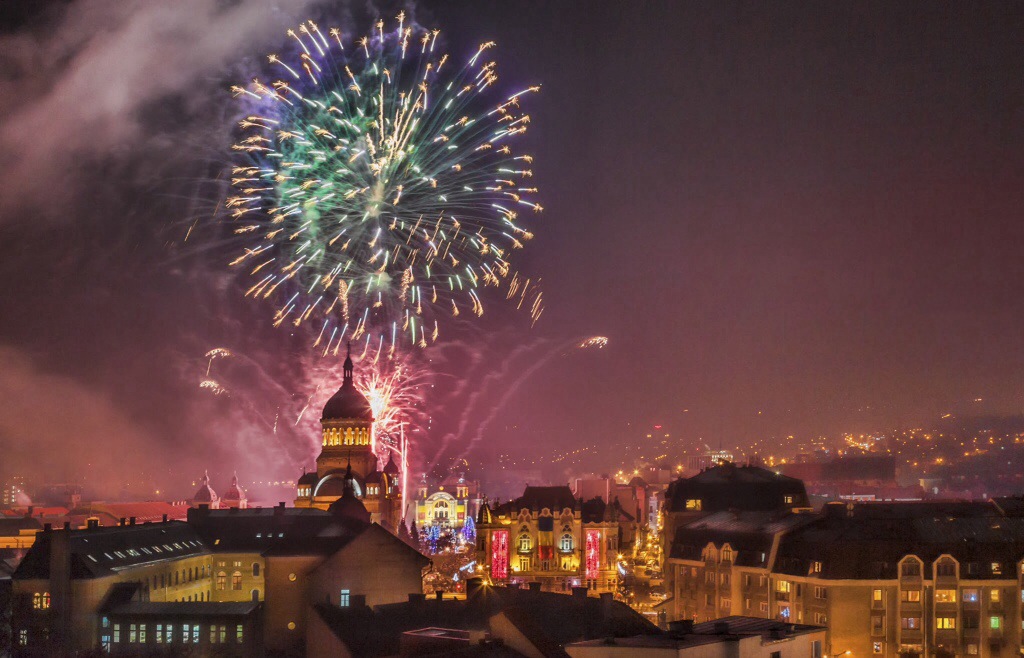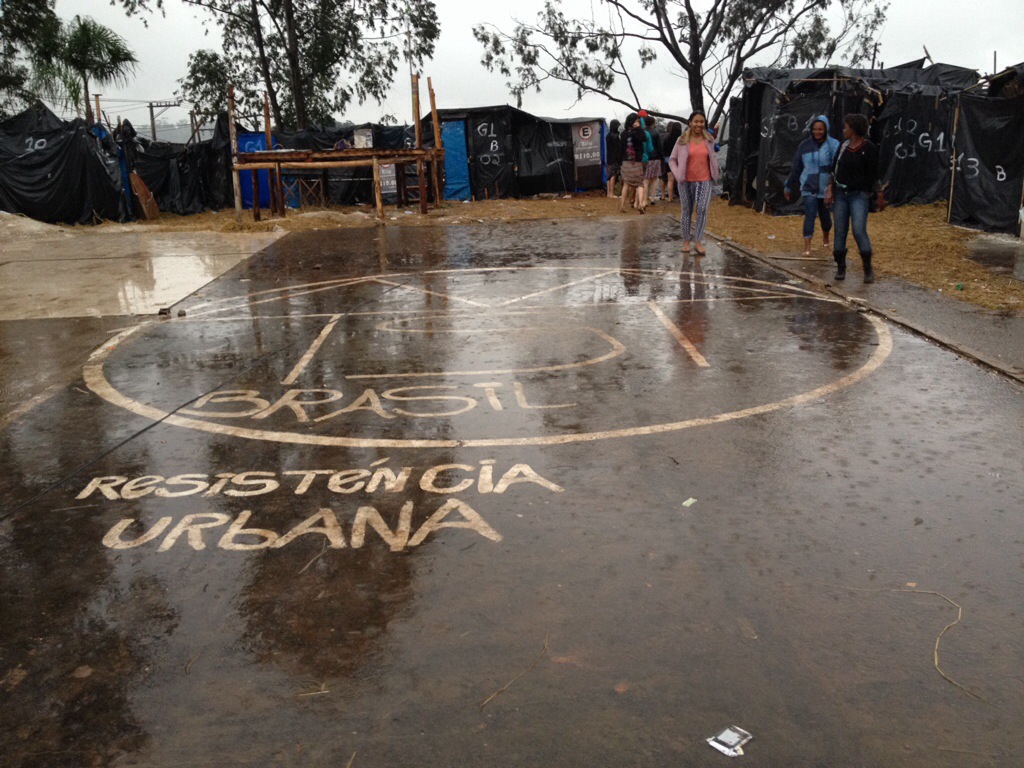
A March in Hounour of 106 Year-old MST Member
Luiz Beltrame is a poet and MST activist from the state of Sao Paulo. He is 106 years old.
Born in Paramirim in the state of Bahia on October 11, 1908, he worked from a young age in the fields, in mining, and harvesting cotton. He did not attend school but learned to read and write with his father at age 14. In 1991 he came to the Reunidas Settlement in Promissão. Luiz has eight children, 47 grandchildren and an ever growing posterity.
In 1997 he gained popularity among members of the MST for his participation in the March for Agrarian Reform, Jobs and Justice at the age of 89.
Since then he’s participated in ten marches, wrote two books, and his story has been documented in a film titled Luiz the Poet (Luiz Poeta) directed by Bruno Benedetti, Fabio Eitelberg and others. It was the winner of the Short Box Contest in the documentary category. The march on May 8th, 2014 was named in honour of Luiz.
Getting Ready to Mobilize
While talking to a couple of people a woman tells me ,”The reason we named the march the Luiz Beltrame March is because he’s a great supporter of the Movement.” She wears a yellow shirt with Luiz’s face stenciled on it.
During the same conversation another man speaks up and declares matter-of-fact “He’s going to be here tomorrow.”
But Luiz is a no show this morning; he was never scheduled to be at the march. The group of just over 900 people are camped inside a local school in a middle-class neighbourhood of Sao Paulo waiting for the final word to mobilize. They have been instructed that they will march five kilometers to their intended target to protest in front of a large Brazilian corporation’s head quarters. But the group still does not know who the target is. As the morning progresses a meeting is called in the various nuclei (groups) to inform each group how it will organize. They are told the march will begin at 9am. The crowd grows in excitement.
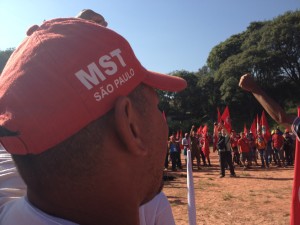
When the final meeting is called shortly before 9am the crowd made up of various rural MST encampments in Sao Paulo begin a morning exercise where they remember the 21 MST members who were murdered on April 17, 1996 by the Military Police at Eldorado dos Carajás. They have their last words of encouragement and are told that this march will be joined by an urban reform group named Movement of Workers Without a Roof (O Movimemto dos Trabalhadores Sem Teto-MTST). The crowed is told not panic when this happens as it will occur at the halfway mark. The march will then grow to include about 1,500 people. They are then told to form two straight lines parallel to each other and to not break formation in case something happens. The group is advised to stick together in single lines and to not venture on their own in Sao Paulo. As the groups make their way out of the school they are organized into lines and are told over loudspeakers the order the various encampments and organizations will follow.
As the lines are made the crowd receives pinnies bearing the MST’s logo on the front and the name “Marcha Luiz Beltrame” on the back. They then descend from the hill where the school is located to a main avenue during Sao Paulo’s rush hour. The group quickly takes over the streets and intersections securing safe passage for the marchers and begins the five kilometer march. Onlookers emerge from their shops and stores to take photos, talk to other passersby or give a thumbs up in approval of the march. The police arrives asking to speak to a communications officer in charge. The first cruiser leaves and is followed by a second who stays close to the marchers ensuring that passing vehicles slow down when passing the crowd. Motorcycle police take the front and back of the march and secure the participants from oncoming traffic. Thus far the march has seen zero aggression or agitation for its disruption of morning traffic. Over the loudspeakers the announcer proclaims,
“We are taking to the streets to protest for Agrarian Reform. We are sorry that this disrupts local traffic but this is an indication of the need for reform.” The announcer declares that the city’s congestion is evidence of the failed reform policies of the rural and urban areas. The announcer is alluding to the decades where Brazil focused on industrializing its major cities causing a massive exodus of the rural population to the cities seeking better employment. As the program failed to meet its targets and was eventually abandoned in the late 70s, coupled with a deep recession in the 80s, millions of rural migrants found city live was anything but glamorous. They made up the largest portion of the urban poor and were unable to afford housing. They settled on the cities’ ridges and outskirts creating chaotic networks of unplanned city blocks and complete neighbourhoods. Known as favelas (shantytowns) the city largely ignored those inhabitants and planned around them creating a difficult city infrastructure.
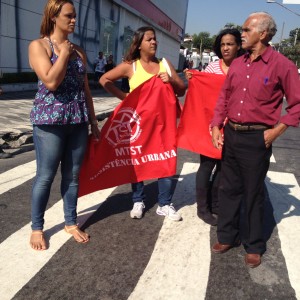
The march reaches it’s halfway point and finds itself in the middle of a crossroads. About 600 members of the MTST rush into the lines of the MST march and are received with loud approval from the crowd. They quickly take over the entire avenue causing the traffic to come to a standstill. Suddenly, another movement of young students joins the march braking the neatly formed lines and creating a sense of chaos. They march along the avenue without any form of organization. The MST members assigned as security quickly regroup the marchers and instruct them to continue in their two-line single-file formation. The marchers are sifted and separated by movements (MST, MTST) and realign themselves in the avenue so as to permit traffic to continue flowing through one lane.
As the march reaches a major overpass it is redirected toward a less congested street in front of a large skyscraper. Without warning the front half of the march rushes into the building and begins throwing paint bombs on the facade. A group of designated painters spray paint slogans and stencils on the glass, walls and columns of the building’s entrance and logo. A group of 200 or so rush into the lobby of the building and begin chanting anti-capitalist slogans. The woman on the loudspeaker declares that this is the target: Brazil’s largest conglomerate called Odebrecht.
The company is Brazil’s largest and has operations at home and abroad in oil and gas, infrastructure, mining, exploration, agribusiness (producing ethanol and various bio-fuels) and many more. It won the rights to construct many of the World Cup venues and has large construction projects in the US such as the Miami airport. According to the protesters in 2013 it made over $6billion BRL ($3 billion CAD) in revenue from it operations and currently receives large government funding in order to sustain its agribusiness, money they argue that could have gone toward social programs. The media reported two more simultaneous flash manifestations on two other Edobrecht buildings in the city. For about 45 minutes the crowd denounces abuses the company’s management has neglected to recognize such as child labour, rural slavery and contamination of water ways and soil among many. After this time the protesters are told to regroup and reform the lines so as to begin the five kilometer march back.
The elated crowd now marches to the tune of forró, hip hop and international reggaeton as it celebrates its “victory.” A confrontation that could have been potentially dangerous benefited from the element of surprise; police presence was small and none confrontational. As the march makes makes its way back to the school grounds (all the while chanting and singing along to popular MST songs), the announcers repeat the accounts of the past hour to onlookers who stare at the sea of red with curiosity and others with faint approval. When the march finally reaches its final destination the members disband, rest and get ready for lunch. A new struggle will begin: the struggle to fight hunger and the urge to not cut the line while awaiting food.
Gallery
Click on any image to start viewing the gallery. The gallery make time a few seconds to load between photos.
- Members of the MTST stand on the crosswalk during a march on May 8, 2014.









